Leadership in Organizational Settings: Culture, Change & Solutions
VerifiedAdded on 2023/06/12
|8
|2010
|134
Essay
AI Summary
This essay examines the significant role of leadership in shaping organizational culture and driving change within businesses. It discusses how different leadership styles, including authentic and transformational leadership, impact employee attitudes, ethical considerations, and overall organizational performance. The essay highlights the increasing importance of authentic leadership, particularly in addressing issues of trust and accountability. It also explores how authentic and transformational leadership techniques can be applied to solve problems such as wrongful marketing, ethical lapses, and harassment, emphasizing the need for transparency, responsibility, and proactive measures to maintain a positive organizational image. The analysis concludes that effective leadership is crucial for adapting to change, fostering a positive organizational culture, and ensuring long-term business success.
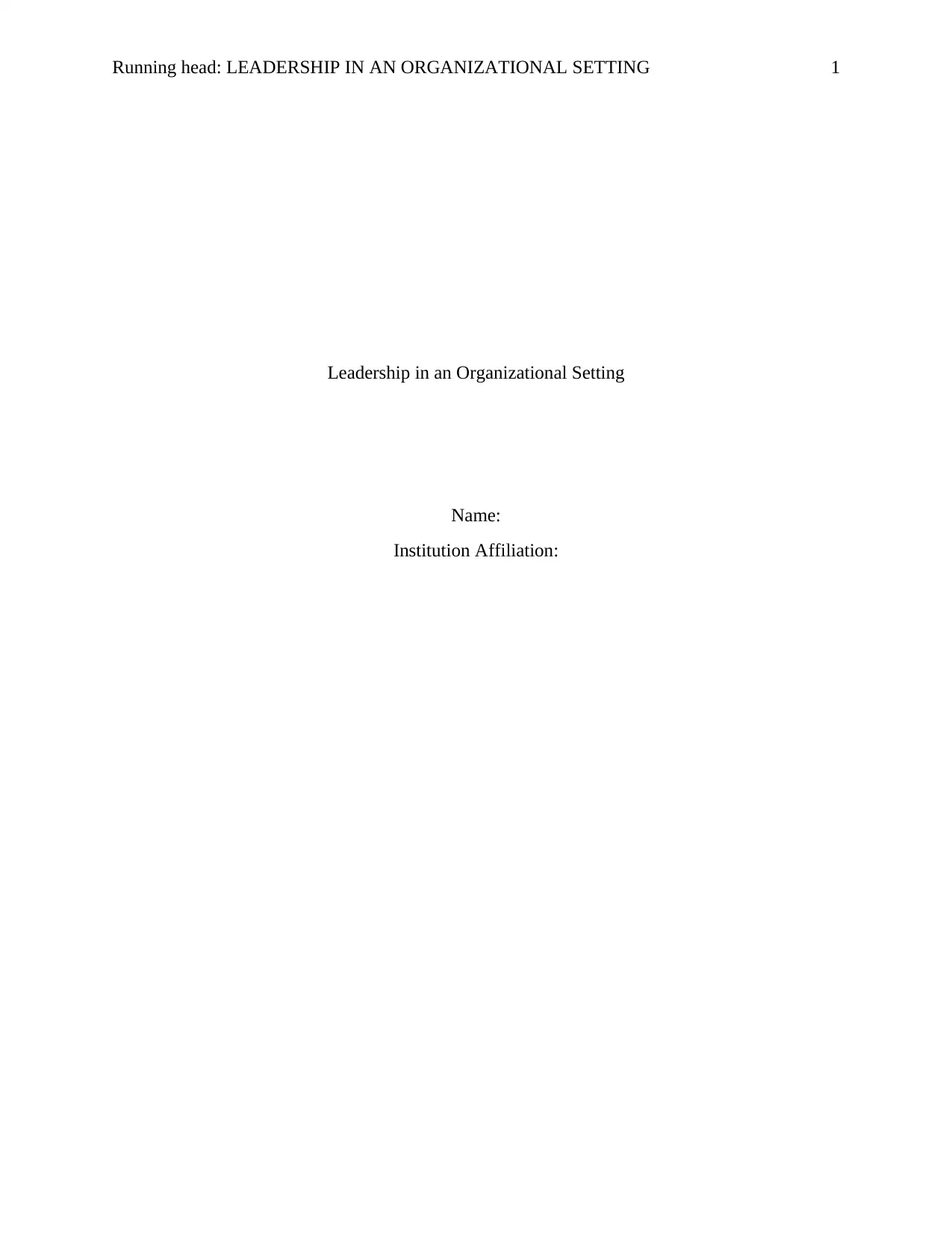
Running head: LEADERSHIP IN AN ORGANIZATIONAL SETTING 1
Leadership in an Organizational Setting
Name:
Institution Affiliation:
Leadership in an Organizational Setting
Name:
Institution Affiliation:
Paraphrase This Document
Need a fresh take? Get an instant paraphrase of this document with our AI Paraphraser
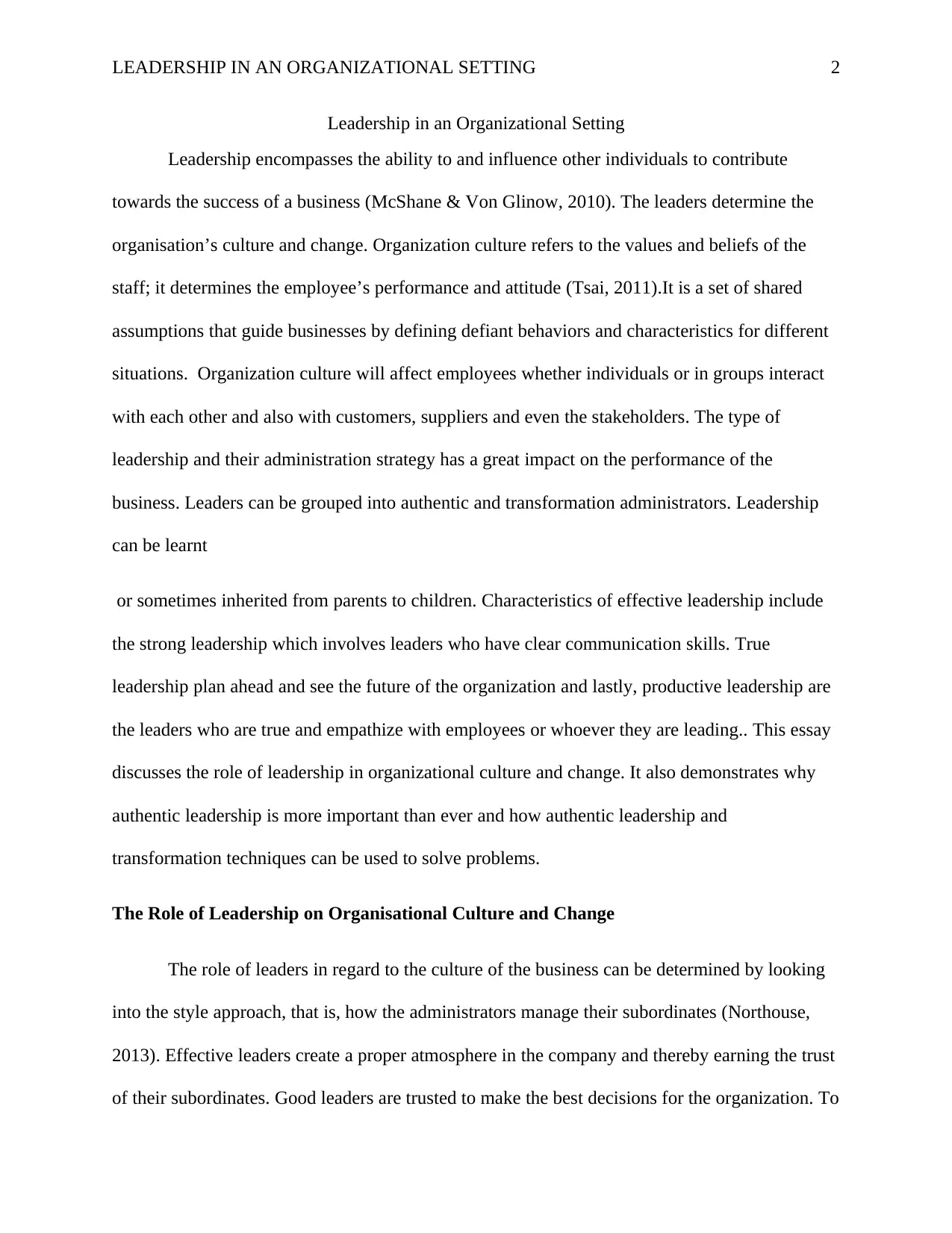
LEADERSHIP IN AN ORGANIZATIONAL SETTING 2
Leadership in an Organizational Setting
Leadership encompasses the ability to and influence other individuals to contribute
towards the success of a business (McShane & Von Glinow, 2010). The leaders determine the
organisation’s culture and change. Organization culture refers to the values and beliefs of the
staff; it determines the employee’s performance and attitude (Tsai, 2011).It is a set of shared
assumptions that guide businesses by defining defiant behaviors and characteristics for different
situations. Organization culture will affect employees whether individuals or in groups interact
with each other and also with customers, suppliers and even the stakeholders. The type of
leadership and their administration strategy has a great impact on the performance of the
business. Leaders can be grouped into authentic and transformation administrators. Leadership
can be learnt
or sometimes inherited from parents to children. Characteristics of effective leadership include
the strong leadership which involves leaders who have clear communication skills. True
leadership plan ahead and see the future of the organization and lastly, productive leadership are
the leaders who are true and empathize with employees or whoever they are leading.. This essay
discusses the role of leadership in organizational culture and change. It also demonstrates why
authentic leadership is more important than ever and how authentic leadership and
transformation techniques can be used to solve problems.
The Role of Leadership on Organisational Culture and Change
The role of leaders in regard to the culture of the business can be determined by looking
into the style approach, that is, how the administrators manage their subordinates (Northouse,
2013). Effective leaders create a proper atmosphere in the company and thereby earning the trust
of their subordinates. Good leaders are trusted to make the best decisions for the organization. To
Leadership in an Organizational Setting
Leadership encompasses the ability to and influence other individuals to contribute
towards the success of a business (McShane & Von Glinow, 2010). The leaders determine the
organisation’s culture and change. Organization culture refers to the values and beliefs of the
staff; it determines the employee’s performance and attitude (Tsai, 2011).It is a set of shared
assumptions that guide businesses by defining defiant behaviors and characteristics for different
situations. Organization culture will affect employees whether individuals or in groups interact
with each other and also with customers, suppliers and even the stakeholders. The type of
leadership and their administration strategy has a great impact on the performance of the
business. Leaders can be grouped into authentic and transformation administrators. Leadership
can be learnt
or sometimes inherited from parents to children. Characteristics of effective leadership include
the strong leadership which involves leaders who have clear communication skills. True
leadership plan ahead and see the future of the organization and lastly, productive leadership are
the leaders who are true and empathize with employees or whoever they are leading.. This essay
discusses the role of leadership in organizational culture and change. It also demonstrates why
authentic leadership is more important than ever and how authentic leadership and
transformation techniques can be used to solve problems.
The Role of Leadership on Organisational Culture and Change
The role of leaders in regard to the culture of the business can be determined by looking
into the style approach, that is, how the administrators manage their subordinates (Northouse,
2013). Effective leaders create a proper atmosphere in the company and thereby earning the trust
of their subordinates. Good leaders are trusted to make the best decisions for the organization. To
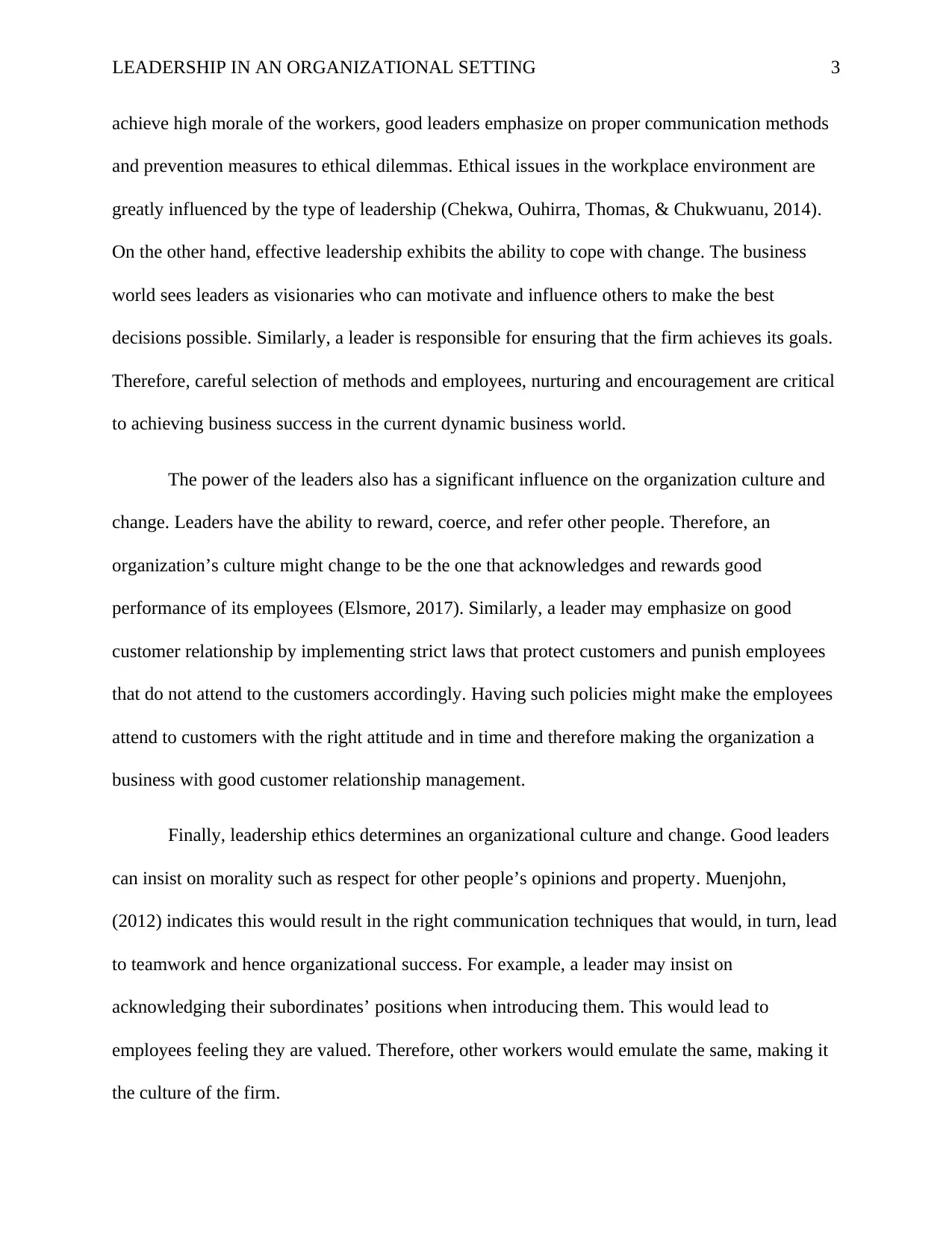
LEADERSHIP IN AN ORGANIZATIONAL SETTING 3
achieve high morale of the workers, good leaders emphasize on proper communication methods
and prevention measures to ethical dilemmas. Ethical issues in the workplace environment are
greatly influenced by the type of leadership (Chekwa, Ouhirra, Thomas, & Chukwuanu, 2014).
On the other hand, effective leadership exhibits the ability to cope with change. The business
world sees leaders as visionaries who can motivate and influence others to make the best
decisions possible. Similarly, a leader is responsible for ensuring that the firm achieves its goals.
Therefore, careful selection of methods and employees, nurturing and encouragement are critical
to achieving business success in the current dynamic business world.
The power of the leaders also has a significant influence on the organization culture and
change. Leaders have the ability to reward, coerce, and refer other people. Therefore, an
organization’s culture might change to be the one that acknowledges and rewards good
performance of its employees (Elsmore, 2017). Similarly, a leader may emphasize on good
customer relationship by implementing strict laws that protect customers and punish employees
that do not attend to the customers accordingly. Having such policies might make the employees
attend to customers with the right attitude and in time and therefore making the organization a
business with good customer relationship management.
Finally, leadership ethics determines an organizational culture and change. Good leaders
can insist on morality such as respect for other people’s opinions and property. Muenjohn,
(2012) indicates this would result in the right communication techniques that would, in turn, lead
to teamwork and hence organizational success. For example, a leader may insist on
acknowledging their subordinates’ positions when introducing them. This would lead to
employees feeling they are valued. Therefore, other workers would emulate the same, making it
the culture of the firm.
achieve high morale of the workers, good leaders emphasize on proper communication methods
and prevention measures to ethical dilemmas. Ethical issues in the workplace environment are
greatly influenced by the type of leadership (Chekwa, Ouhirra, Thomas, & Chukwuanu, 2014).
On the other hand, effective leadership exhibits the ability to cope with change. The business
world sees leaders as visionaries who can motivate and influence others to make the best
decisions possible. Similarly, a leader is responsible for ensuring that the firm achieves its goals.
Therefore, careful selection of methods and employees, nurturing and encouragement are critical
to achieving business success in the current dynamic business world.
The power of the leaders also has a significant influence on the organization culture and
change. Leaders have the ability to reward, coerce, and refer other people. Therefore, an
organization’s culture might change to be the one that acknowledges and rewards good
performance of its employees (Elsmore, 2017). Similarly, a leader may emphasize on good
customer relationship by implementing strict laws that protect customers and punish employees
that do not attend to the customers accordingly. Having such policies might make the employees
attend to customers with the right attitude and in time and therefore making the organization a
business with good customer relationship management.
Finally, leadership ethics determines an organizational culture and change. Good leaders
can insist on morality such as respect for other people’s opinions and property. Muenjohn,
(2012) indicates this would result in the right communication techniques that would, in turn, lead
to teamwork and hence organizational success. For example, a leader may insist on
acknowledging their subordinates’ positions when introducing them. This would lead to
employees feeling they are valued. Therefore, other workers would emulate the same, making it
the culture of the firm.
⊘ This is a preview!⊘
Do you want full access?
Subscribe today to unlock all pages.

Trusted by 1+ million students worldwide
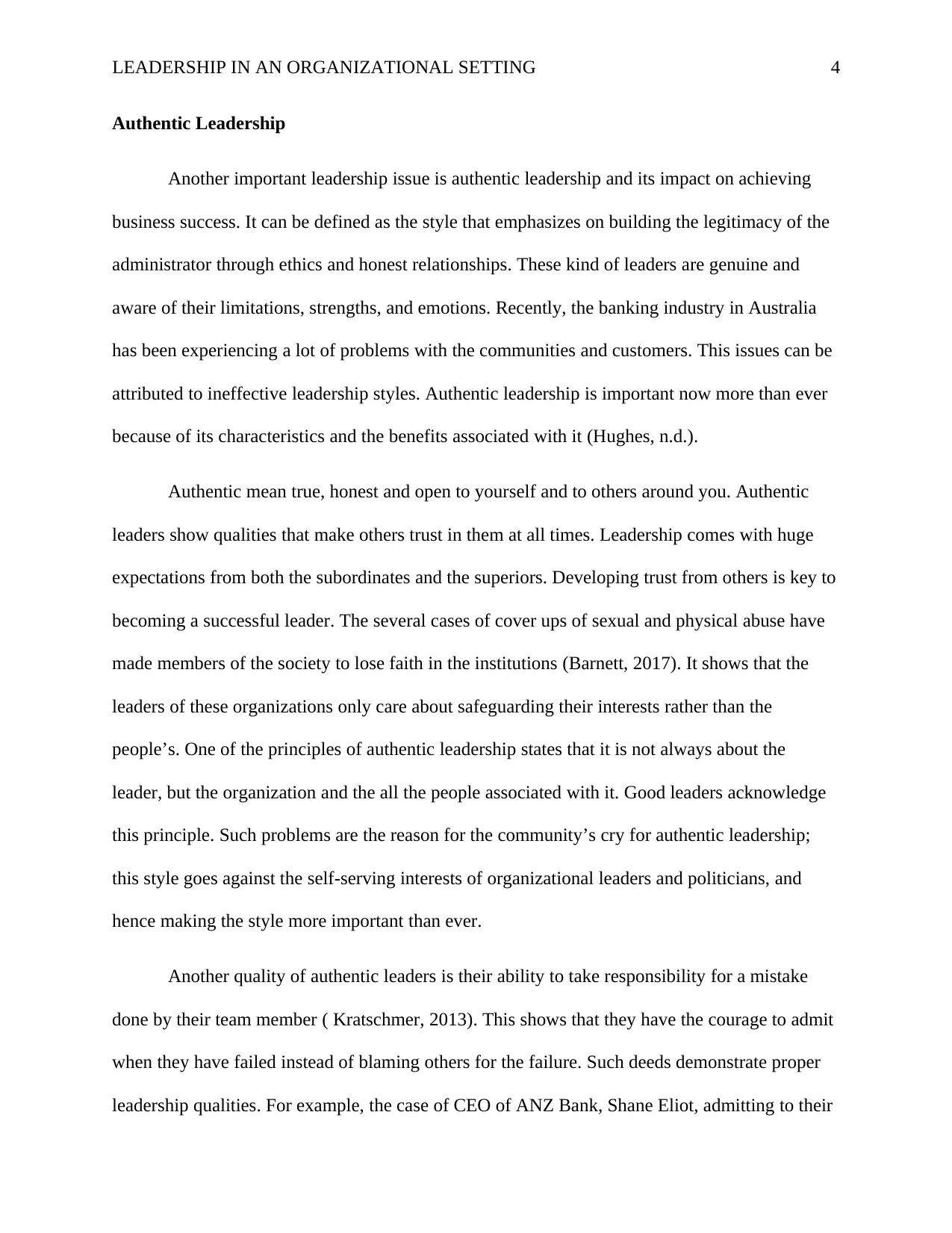
LEADERSHIP IN AN ORGANIZATIONAL SETTING 4
Authentic Leadership
Another important leadership issue is authentic leadership and its impact on achieving
business success. It can be defined as the style that emphasizes on building the legitimacy of the
administrator through ethics and honest relationships. These kind of leaders are genuine and
aware of their limitations, strengths, and emotions. Recently, the banking industry in Australia
has been experiencing a lot of problems with the communities and customers. This issues can be
attributed to ineffective leadership styles. Authentic leadership is important now more than ever
because of its characteristics and the benefits associated with it (Hughes, n.d.).
Authentic mean true, honest and open to yourself and to others around you. Authentic
leaders show qualities that make others trust in them at all times. Leadership comes with huge
expectations from both the subordinates and the superiors. Developing trust from others is key to
becoming a successful leader. The several cases of cover ups of sexual and physical abuse have
made members of the society to lose faith in the institutions (Barnett, 2017). It shows that the
leaders of these organizations only care about safeguarding their interests rather than the
people’s. One of the principles of authentic leadership states that it is not always about the
leader, but the organization and the all the people associated with it. Good leaders acknowledge
this principle. Such problems are the reason for the community’s cry for authentic leadership;
this style goes against the self-serving interests of organizational leaders and politicians, and
hence making the style more important than ever.
Another quality of authentic leaders is their ability to take responsibility for a mistake
done by their team member ( Kratschmer, 2013). This shows that they have the courage to admit
when they have failed instead of blaming others for the failure. Such deeds demonstrate proper
leadership qualities. For example, the case of CEO of ANZ Bank, Shane Eliot, admitting to their
Authentic Leadership
Another important leadership issue is authentic leadership and its impact on achieving
business success. It can be defined as the style that emphasizes on building the legitimacy of the
administrator through ethics and honest relationships. These kind of leaders are genuine and
aware of their limitations, strengths, and emotions. Recently, the banking industry in Australia
has been experiencing a lot of problems with the communities and customers. This issues can be
attributed to ineffective leadership styles. Authentic leadership is important now more than ever
because of its characteristics and the benefits associated with it (Hughes, n.d.).
Authentic mean true, honest and open to yourself and to others around you. Authentic
leaders show qualities that make others trust in them at all times. Leadership comes with huge
expectations from both the subordinates and the superiors. Developing trust from others is key to
becoming a successful leader. The several cases of cover ups of sexual and physical abuse have
made members of the society to lose faith in the institutions (Barnett, 2017). It shows that the
leaders of these organizations only care about safeguarding their interests rather than the
people’s. One of the principles of authentic leadership states that it is not always about the
leader, but the organization and the all the people associated with it. Good leaders acknowledge
this principle. Such problems are the reason for the community’s cry for authentic leadership;
this style goes against the self-serving interests of organizational leaders and politicians, and
hence making the style more important than ever.
Another quality of authentic leaders is their ability to take responsibility for a mistake
done by their team member ( Kratschmer, 2013). This shows that they have the courage to admit
when they have failed instead of blaming others for the failure. Such deeds demonstrate proper
leadership qualities. For example, the case of CEO of ANZ Bank, Shane Eliot, admitting to their
Paraphrase This Document
Need a fresh take? Get an instant paraphrase of this document with our AI Paraphraser
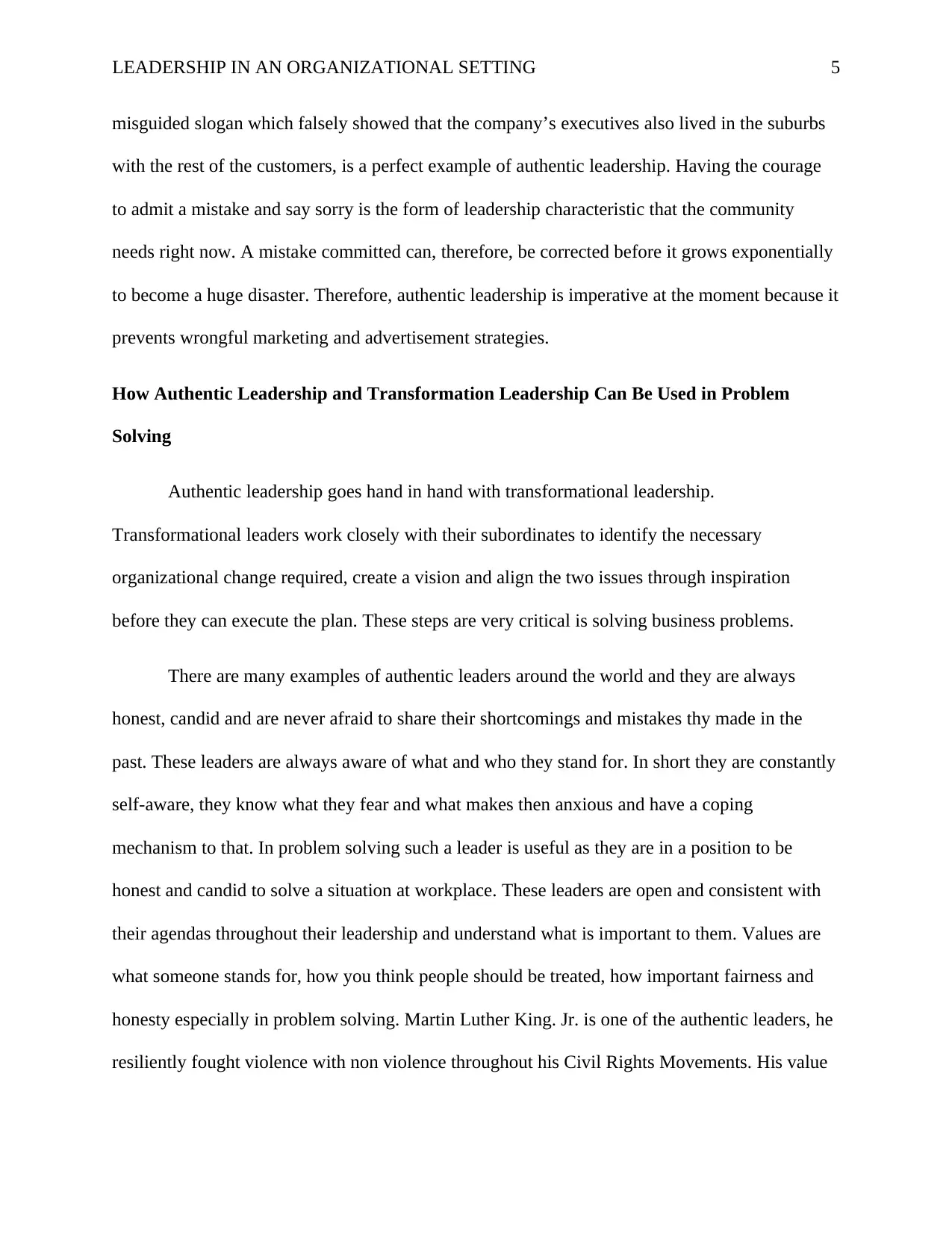
LEADERSHIP IN AN ORGANIZATIONAL SETTING 5
misguided slogan which falsely showed that the company’s executives also lived in the suburbs
with the rest of the customers, is a perfect example of authentic leadership. Having the courage
to admit a mistake and say sorry is the form of leadership characteristic that the community
needs right now. A mistake committed can, therefore, be corrected before it grows exponentially
to become a huge disaster. Therefore, authentic leadership is imperative at the moment because it
prevents wrongful marketing and advertisement strategies.
How Authentic Leadership and Transformation Leadership Can Be Used in Problem
Solving
Authentic leadership goes hand in hand with transformational leadership.
Transformational leaders work closely with their subordinates to identify the necessary
organizational change required, create a vision and align the two issues through inspiration
before they can execute the plan. These steps are very critical is solving business problems.
There are many examples of authentic leaders around the world and they are always
honest, candid and are never afraid to share their shortcomings and mistakes thy made in the
past. These leaders are always aware of what and who they stand for. In short they are constantly
self-aware, they know what they fear and what makes then anxious and have a coping
mechanism to that. In problem solving such a leader is useful as they are in a position to be
honest and candid to solve a situation at workplace. These leaders are open and consistent with
their agendas throughout their leadership and understand what is important to them. Values are
what someone stands for, how you think people should be treated, how important fairness and
honesty especially in problem solving. Martin Luther King. Jr. is one of the authentic leaders, he
resiliently fought violence with non violence throughout his Civil Rights Movements. His value
misguided slogan which falsely showed that the company’s executives also lived in the suburbs
with the rest of the customers, is a perfect example of authentic leadership. Having the courage
to admit a mistake and say sorry is the form of leadership characteristic that the community
needs right now. A mistake committed can, therefore, be corrected before it grows exponentially
to become a huge disaster. Therefore, authentic leadership is imperative at the moment because it
prevents wrongful marketing and advertisement strategies.
How Authentic Leadership and Transformation Leadership Can Be Used in Problem
Solving
Authentic leadership goes hand in hand with transformational leadership.
Transformational leaders work closely with their subordinates to identify the necessary
organizational change required, create a vision and align the two issues through inspiration
before they can execute the plan. These steps are very critical is solving business problems.
There are many examples of authentic leaders around the world and they are always
honest, candid and are never afraid to share their shortcomings and mistakes thy made in the
past. These leaders are always aware of what and who they stand for. In short they are constantly
self-aware, they know what they fear and what makes then anxious and have a coping
mechanism to that. In problem solving such a leader is useful as they are in a position to be
honest and candid to solve a situation at workplace. These leaders are open and consistent with
their agendas throughout their leadership and understand what is important to them. Values are
what someone stands for, how you think people should be treated, how important fairness and
honesty especially in problem solving. Martin Luther King. Jr. is one of the authentic leaders, he
resiliently fought violence with non violence throughout his Civil Rights Movements. His value
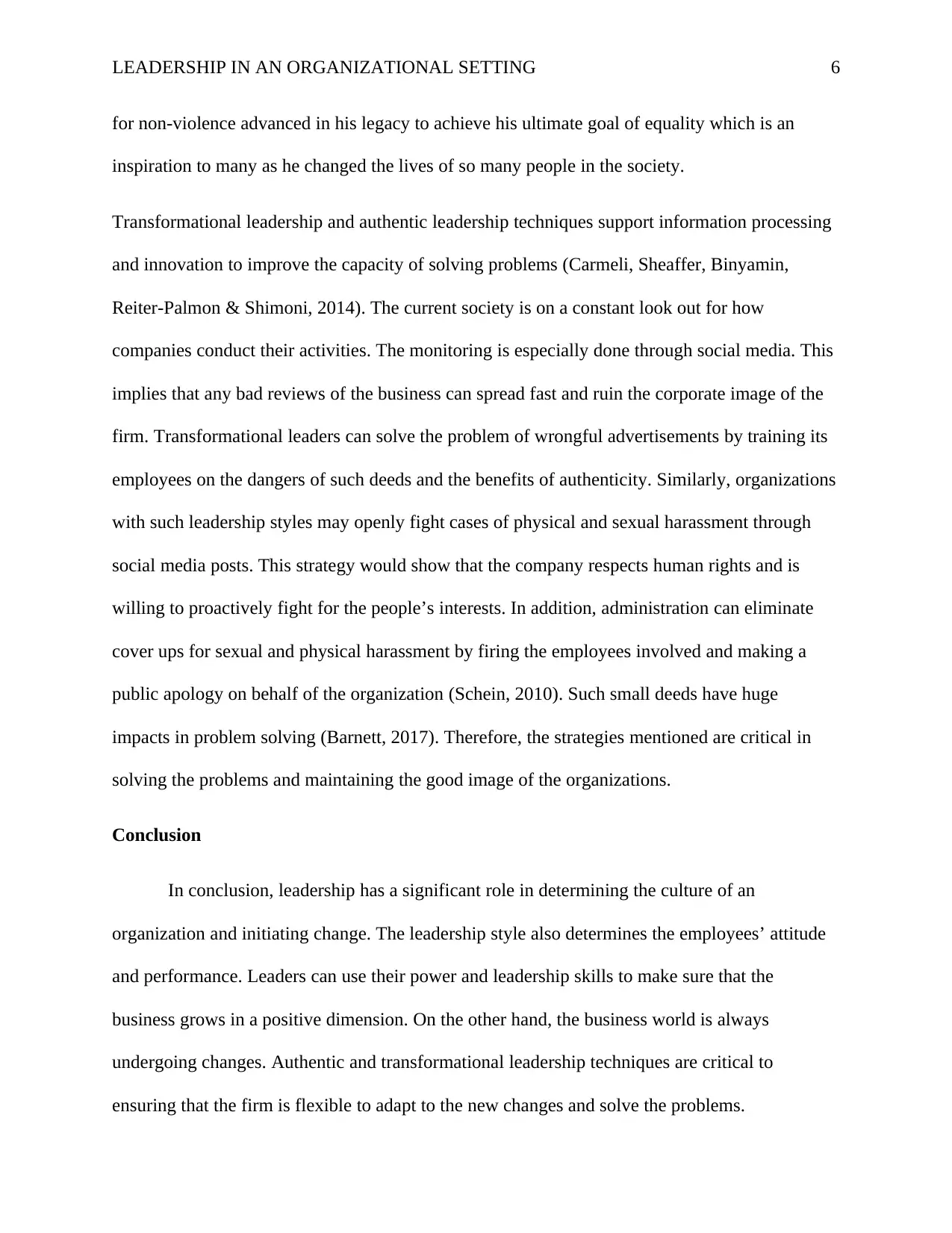
LEADERSHIP IN AN ORGANIZATIONAL SETTING 6
for non-violence advanced in his legacy to achieve his ultimate goal of equality which is an
inspiration to many as he changed the lives of so many people in the society.
Transformational leadership and authentic leadership techniques support information processing
and innovation to improve the capacity of solving problems (Carmeli, Sheaffer, Binyamin,
Reiter‐Palmon & Shimoni, 2014). The current society is on a constant look out for how
companies conduct their activities. The monitoring is especially done through social media. This
implies that any bad reviews of the business can spread fast and ruin the corporate image of the
firm. Transformational leaders can solve the problem of wrongful advertisements by training its
employees on the dangers of such deeds and the benefits of authenticity. Similarly, organizations
with such leadership styles may openly fight cases of physical and sexual harassment through
social media posts. This strategy would show that the company respects human rights and is
willing to proactively fight for the people’s interests. In addition, administration can eliminate
cover ups for sexual and physical harassment by firing the employees involved and making a
public apology on behalf of the organization (Schein, 2010). Such small deeds have huge
impacts in problem solving (Barnett, 2017). Therefore, the strategies mentioned are critical in
solving the problems and maintaining the good image of the organizations.
Conclusion
In conclusion, leadership has a significant role in determining the culture of an
organization and initiating change. The leadership style also determines the employees’ attitude
and performance. Leaders can use their power and leadership skills to make sure that the
business grows in a positive dimension. On the other hand, the business world is always
undergoing changes. Authentic and transformational leadership techniques are critical to
ensuring that the firm is flexible to adapt to the new changes and solve the problems.
for non-violence advanced in his legacy to achieve his ultimate goal of equality which is an
inspiration to many as he changed the lives of so many people in the society.
Transformational leadership and authentic leadership techniques support information processing
and innovation to improve the capacity of solving problems (Carmeli, Sheaffer, Binyamin,
Reiter‐Palmon & Shimoni, 2014). The current society is on a constant look out for how
companies conduct their activities. The monitoring is especially done through social media. This
implies that any bad reviews of the business can spread fast and ruin the corporate image of the
firm. Transformational leaders can solve the problem of wrongful advertisements by training its
employees on the dangers of such deeds and the benefits of authenticity. Similarly, organizations
with such leadership styles may openly fight cases of physical and sexual harassment through
social media posts. This strategy would show that the company respects human rights and is
willing to proactively fight for the people’s interests. In addition, administration can eliminate
cover ups for sexual and physical harassment by firing the employees involved and making a
public apology on behalf of the organization (Schein, 2010). Such small deeds have huge
impacts in problem solving (Barnett, 2017). Therefore, the strategies mentioned are critical in
solving the problems and maintaining the good image of the organizations.
Conclusion
In conclusion, leadership has a significant role in determining the culture of an
organization and initiating change. The leadership style also determines the employees’ attitude
and performance. Leaders can use their power and leadership skills to make sure that the
business grows in a positive dimension. On the other hand, the business world is always
undergoing changes. Authentic and transformational leadership techniques are critical to
ensuring that the firm is flexible to adapt to the new changes and solve the problems.
⊘ This is a preview!⊘
Do you want full access?
Subscribe today to unlock all pages.

Trusted by 1+ million students worldwide

LEADERSHIP IN AN ORGANIZATIONAL SETTING 7
Paraphrase This Document
Need a fresh take? Get an instant paraphrase of this document with our AI Paraphraser
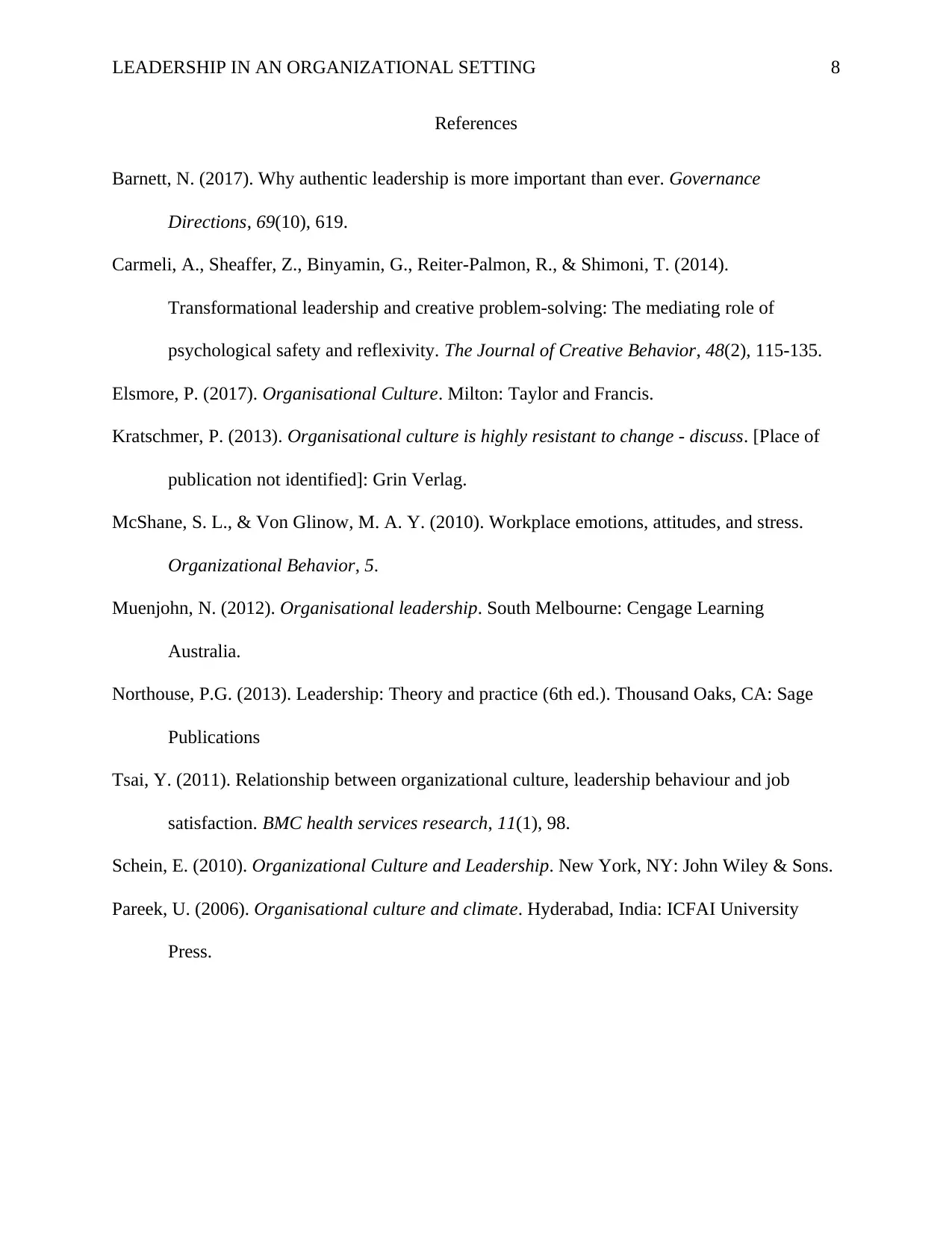
LEADERSHIP IN AN ORGANIZATIONAL SETTING 8
References
Barnett, N. (2017). Why authentic leadership is more important than ever. Governance
Directions, 69(10), 619.
Carmeli, A., Sheaffer, Z., Binyamin, G., Reiter‐Palmon, R., & Shimoni, T. (2014).
Transformational leadership and creative problem‐solving: The mediating role of
psychological safety and reflexivity. The Journal of Creative Behavior, 48(2), 115-135.
Elsmore, P. (2017). Organisational Culture. Milton: Taylor and Francis.
Kratschmer, P. (2013). Organisational culture is highly resistant to change - discuss. [Place of
publication not identified]: Grin Verlag.
McShane, S. L., & Von Glinow, M. A. Y. (2010). Workplace emotions, attitudes, and stress.
Organizational Behavior, 5.
Muenjohn, N. (2012). Organisational leadership. South Melbourne: Cengage Learning
Australia.
Northouse, P.G. (2013). Leadership: Theory and practice (6th ed.). Thousand Oaks, CA: Sage
Publications
Tsai, Y. (2011). Relationship between organizational culture, leadership behaviour and job
satisfaction. BMC health services research, 11(1), 98.
Schein, E. (2010). Organizational Culture and Leadership. New York, NY: John Wiley & Sons.
Pareek, U. (2006). Organisational culture and climate. Hyderabad, India: ICFAI University
Press.
References
Barnett, N. (2017). Why authentic leadership is more important than ever. Governance
Directions, 69(10), 619.
Carmeli, A., Sheaffer, Z., Binyamin, G., Reiter‐Palmon, R., & Shimoni, T. (2014).
Transformational leadership and creative problem‐solving: The mediating role of
psychological safety and reflexivity. The Journal of Creative Behavior, 48(2), 115-135.
Elsmore, P. (2017). Organisational Culture. Milton: Taylor and Francis.
Kratschmer, P. (2013). Organisational culture is highly resistant to change - discuss. [Place of
publication not identified]: Grin Verlag.
McShane, S. L., & Von Glinow, M. A. Y. (2010). Workplace emotions, attitudes, and stress.
Organizational Behavior, 5.
Muenjohn, N. (2012). Organisational leadership. South Melbourne: Cengage Learning
Australia.
Northouse, P.G. (2013). Leadership: Theory and practice (6th ed.). Thousand Oaks, CA: Sage
Publications
Tsai, Y. (2011). Relationship between organizational culture, leadership behaviour and job
satisfaction. BMC health services research, 11(1), 98.
Schein, E. (2010). Organizational Culture and Leadership. New York, NY: John Wiley & Sons.
Pareek, U. (2006). Organisational culture and climate. Hyderabad, India: ICFAI University
Press.
1 out of 8
Related Documents
Your All-in-One AI-Powered Toolkit for Academic Success.
+13062052269
info@desklib.com
Available 24*7 on WhatsApp / Email
![[object Object]](/_next/static/media/star-bottom.7253800d.svg)
Unlock your academic potential
Copyright © 2020–2025 A2Z Services. All Rights Reserved. Developed and managed by ZUCOL.





